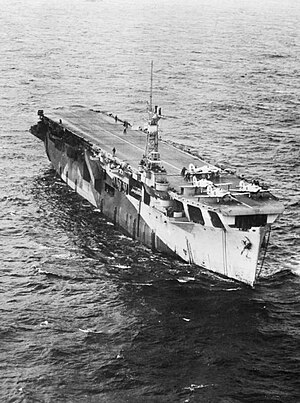HMS Nairana (D05)

HMS Nairana
|
|
| History | |
|---|---|
|
|
|
| Name: | HMS Nairana |
| Builder: | John Brown & Company |
| Laid down: | 7 November 1941 |
| Launched: | 20 May 1943 |
| Commissioned: | 12 December 1943 |
| Decommissioned: | 1946 |
| Identification: | Pennant number D05 |
| Fate: | Transferred to the Royal Netherlands Navy |
|
|
|
| Name: | HNLMS Karel Doorman |
| Namesake: | Karel Doorman |
| Commissioned: | 23 March 1946 |
| Decommissioned: | 28 May 1948 |
| Fate: | returned to Royal Navy |
| United Kingdom | |
| Name: | Port Victor |
| Operator: | Port Line |
| Acquired: | 1948 |
| Fate: | Scrapped 1971 |
| General characteristics | |
| Class and type: | Nairana-class escort carrier |
| Displacement: | 14,050 long tons (14,280 t) |
| Length: | 528 ft 6 in (161.09 m) |
| Beam: | 68 ft 6 in (20.88 m) |
| Draught: | 21 ft (6.4 m) |
| Installed power: | 11,000 hp (8,200 kW) |
| Propulsion: |
|
| Speed: | 17 kn (20 mph; 31 km/h) |
| Complement: | 728 |
| Armament: |
|
| Aircraft carried: | 15–20 |
| Aviation facilities: |
|
HMS Nairana (/naɪˈrɑːnə/) was the lead ship of the Royal Navy's Nairana-class escort carriers that saw service in the Second World War. She was built at John Brown & Company shipyards in Clydebank, Scotland. When construction started in 1941 she was intended as a merchant ship, but was completed and launched as an escort carrier, entering service at the end of 1943.
Nairana operated escorting convoys and doing anti-submarine work in the Atlantic and Arctic theatres. On 26 May 1944, Royal Navy Sea Hurricanes operating from Nairana claimed the destruction of three Junkers Ju 290s during the defence of a convoy. This represented 10 percent of the total German inventory of the type. She survived the war, and in 1946 was transferred to the Dutch Navy as the Karel Doorman (QH1), the first Dutch aircraft carrier. In 1948, she was replaced in the Dutch Navy by another vessel of the same name. Nairana was returned to the Royal Navy, and sold to the Port Line company, becoming the merchant ship Port Victor.
The Nairanas were a class of three escort carriers built for the Royal Navy during the Second World War. Escort carriers were designed to protect convoys of merchant ships from U-boat and aircraft attack. Following the successful conversion and operation of Activity, the Admiralty decided to take over three more merchant ships while they were still under construction and convert them into escort carriers. The three ships chosen were being built at three different shipyards Harland and Wolff in Northern Ireland, Swan Hunter in England and John Brown & Company in Scotland. The prototype was built by John Brown who supplied the other two companies with copies of the plans. The three ships were supposed to be identical but in reality they were all slightly different.
...
Wikipedia
